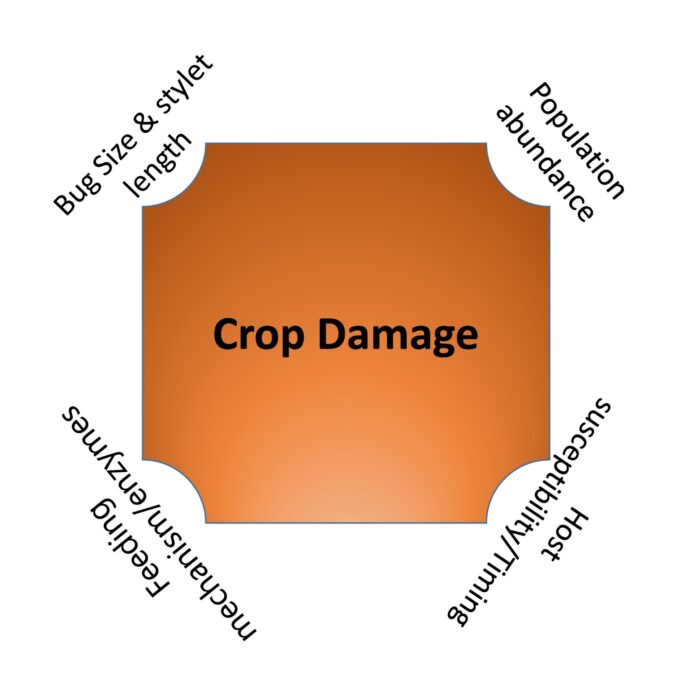This past year, 2023, has been a record year with the greatest crop damage by navel orangeworm (NOW) in almond statewide. While discussions have predominantly centered around NOW management strategies for the upcoming 2024 season, it’s imperative not to overlook the escalating brown spot problem as this issue has not gone away. Brown spot is the general term for hemipteran “true bug” damage in almonds. Hemipteran pests have piercing-sucking mouthparts, and their feeding results in either gummy kernel or necrotic kernel, also known as brown spot, and sometimes the combination of both damage types (Figure 1). Gummy kernel can also be caused by some other physiological reasons, however.

Between 2021-23, we collected harvest samples from 14 to 24 variety/orchard combinations from San Joaquin Valley and found that the average brown spot (excluding gummy kernels) percentage in Nonpareil was higher in 2023 (1.8%) than in 2022 (1.5%), while pollinizer variety damage was slightly lower than Nonpareil in 2023 than previous years in our study (Figure 2). We believe that many brown spots damage in 2023 was likely masked by high level of NOW damage as brown spot occurs earlier than the NOW damage. These hemipteran damage levels are still very substantial.
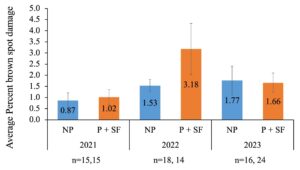
Hemipteran Pests and Their Seasonality
The major hemipteran pests in almond orchards include leaf-footed bug, native stink bugs (red-shouldered, Consperse and green stink bug) and a relatively recently introduced invasive brown marmorated stink bug (BMSB). These pests are present in almond orchards at different densities and at slightly different times in the season (early vs late).
Consequently, the damage symptoms can look a little different for different hemipteran pests’ species. The ultimate economic damage as a result of the large hemipterans feeding in almonds depends on roughly four factors: 1) size of the insect/stylet length, bigger the size, higher the damage; 2) population abundance, presence of additional hosts at or outside of the orchard makes it worse; 3) host susceptibility/timing, feeding by the same insects in different time of the year can produce different signs; and 4) feeding mechanism/enzymes involvement, different species of hemipterans have different blends of digestive or salivary enzymes for softening the fruit content effectively. For example, infestation of developing nuts by both leaf-footed bug and invasive BMSB before the shell-hardening (March to April) mostly results in nut abortion and nut drop, while feeding during May can result in mostly gummy kernels, and the June/July infestation largely results in a typical brown spot with dark circular indentation. Toward the hull split, the hemipteran feeding generally results in lighter, less intense brown spots, which may not even count as rejects at the processing facility.
Invasive BMSB and Native Green Stink Bug on the Rise
We have been conducting seasonal monitoring and surveys of BMSB using multiple methods in San Joaquin Valley for several years. Our survey showed that BMSB has been well-established in several northern San Joaquin Valley orchards and has begun to be found in a few central San Joaquin Valley (Fresno County) in the last two seasons. Since all major hemipteran feeding can result in one of those visual brown spot symptoms and a targeted BMSB trapping in orchards by growers and PCAs is not common, many BMSB damages have likely been unidentified. In northern San Joaquin Valley, BMSB, green stink bug and leaf-footed bug have been found as the major large hemipterans causing damage to almonds in the last three years (Figure 3).
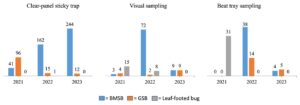
Total number of BMSB, green stink bug (GSB) and leaf-footed bug sampled over the season in 2021-23 using three sampling methods.
There has been increased evidence of native stink bug activities in almond orchards, particularly green stink bugs lately. The green stink bug is not a common pest during the early part of the season, but its occurrence in July through September, especially for susceptible and late-maturing varieties such as Aldrich, Monterey, etc., can cause substantial damage. We have observed their heightened activities in the last few years when conducting almond orchard sampling (Figure 3).
Also, some growers/PCAs occasionally encounter boxelder bug activity in Sacramento and northern San Joaquin Valley orchards close to riparian areas with box elder and other tree hosts nearby. Boxelder bugs in the spring can directly infest the almond fruits, causing small fruits to drop and older nuts to gum or develop brown spots in the kernel (Figure 4). A visual survey of the orchard weeds and trees bordering with alternate host trees helps to spot boxelder bugs. This pest can be a problem before the shell-hardening stage of almonds.
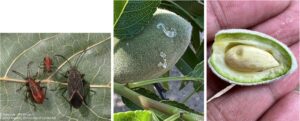
Monitoring Strategies
Hemipteran pest damage in orchards is unpredictable due to a lack of effective traps. No specific traps are available for monitoring leaf-footed bug and native stink bugs. Traps are available for BMSB; their use in California almonds is minimal because growers and PCAs are mostly unaware of this pest in almonds. This is because of its limited known distribution in commercial orchards in the Central Valley. Although tedious, the best ways to monitor hemipterans in almond orchards are by visually sampling the canopy, particularly on the sunny side of the trees in orchard edges, and performing beating tray sampling. Visual observation of gummy fruits is an indicator of feeding damage and can be taken as confirmation of the damage.
Managing Hemipterans in Almond Orchards
There are no economic thresholds for any hemipteran pests in almonds. BMSB and leaf-footed bug can cause nut damage from the beginning of the season when they migrate from overwintering places to the orchard, and their presence from March to May can result in substantial damage and economic loss. So, upon detection, orchards may warrant insecticide sprays. In commercial orchards, pyrethroid-based insecticides have the greatest efficacy against hemipterans, but due to the potential impact of these insecticides on mite predators, their use is not recommended unless it is necessary. A few other alternative insecticides based on our recent trial are presented in Figure 5. In this study, three trees were sprayed with the same insecticide and replicated four times. The orchard was the 4th leaf of the Independence variety and had a history of stink bug activities and damage.
Despite growers’ attention on NOW, there was substantial hemipteran damage to almonds in the 2023 season, and the activities of hemipteran pests, mostly stink bugs and leaf-footed bugs, were steady.
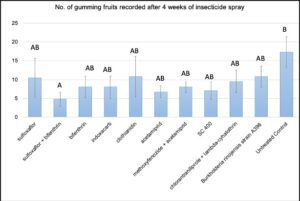
These large hemipterans feed on developing almond fruits, which produce brown spots and gummy kernels. With the increased brown spot damage in orchards, scouting orchards in the spring using available monitoring tools, such as clear panel sticky trapping, visual surveys and beat tray samplings, is critical to detecting the hemipteran pests’ activity on time and making treatment decisions as early as possible.
The authors would like to thank the Almond Board of California for providing funding to conduct hemipteran pest studies in almonds. Thanks to all collaborators and grower cooperators. Thanks to D. Rivers, K. Vue, D. Green and J. Peacock for their technical help.
Mention of trade names or commercial products in this publication is solely for the purpose of providing specific information and does not imply recommendation or endorsement by the U.S. Department of Agriculture (USDA) or any of the other author affiliations. USDA is an equal opportunity provider and employer.
Some of the insecticides mentioned might be for experimental use. So, please follow the label instructions before applying any insecticides.







